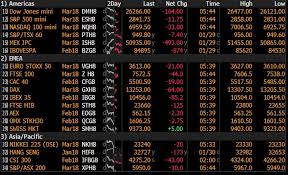Oversupply angst drags oil lower, stocks drift near highs

Oil prices fell sharply on Tuesday on oversupply concerns, while a gauge of stocks across the globe rose for a seventh straight session after large overnight gains in Asia.
The U.S. benchmark S&P 500 index was little changed, the blue-chip Dow Jones Industrial Average fell and the Nasdaq rose, all having hit record intraday highs earlier in the session.
Traders cited the lingering uncertainty over whether the United States and China could agree to end a near 1-1/2 year trade war as a reason for stocks to drift and bond prices to go higher.
U.S. President Donald Trump said he would raise tariffs on Chinese imports if no deal is reached with Beijing to end the trade war. The next round of tariffs is due to start in mid-December.
Oil fell after sources told Reuters that Russia is unlikely to agree to cut its oil output further at a meeting with fellow exporters next month.
Separately, Norway’s October oil production beat forecasts and the potential oversupply, combined with some worries over global demand next year, sent prices lower.
“Moreover, Russia also failed to fulfill its agreed cuts in November so far,” Commerzbank analyst Carsten Fritsch said.
U.S. crude CLc1 fell 3.38% to $ 55.12 per barrel and Brent LCOc1 was last at $ 60.73, down 2.74% on the day.
On Wall Street, the Dow Jones Industrial Average .DJI fell 102.2 points, or 0.36%, to 27,934.02, the S&P 500 .SPX lost 1.85 points, or 0.06%, to 3,120.18 and the Nasdaq Composite .IXIC added 20.72 points, or 0.24%, to 8,570.66.
Hopes of a trade truce earlier in the day drove European stocks to a four-year high and a measure of world stock markets to their highest in nearly two years, but those gains were pared later in the session.
The pan-European STOXX 600 index lost 0.12% while MSCI’s gauge of stocks across the globe .MIWD00000PUS gained 0.02% eking out its seventh straight session of gains.
Emerging market stocks rose 0.48%. MSCI’s broadest index of Asia-Pacific shares outside Japan .MIAPJ0000PUS closed 0.68% higher, while Japan’s Nikkei futures NKc1 lost 0.66%.
Long-dated U.S. Treasury yields slipped as risk appetite weakened.
Benchmark 10-year notes US10YT=RR last rose 7/32 in price to yield 1.786%, down from 1.808% late on Monday.
The 30-year bond US30YT=RR last rose 29/32 in price to yield 2.252%, from 2.293% late on Monday.
The dollar was little changed against a basket of six major currencies. The dollar index .DXY rose 0.05%, with the euro EUR= up 0.05% to $ 1.1075.
While the dollar was supported by recent U.S. economic data meeting lowered expectations, the greenback may be in for some weakness, said Juan Perez, senior foreign exchange trader and strategist at Tempus Inc.
“Central banks cannot provide that much to incentivize stocks any higher, thus risk-appetite is muted and the buck may continue to lose based on the fact that the American economy is indeed slower and the Fed’s ability to satisfy anyone is in question,” Perez said.
The Japanese yen strengthened 0.13% versus the greenback at 108.55 per dollar, while Sterling GBP= was last trading at $ 1.2925, down 0.21% on the day.
Spot gold XAU= added 0.1% to $ 1,472.19 an ounce.
Copper CMCU3 rose 0.86% to $ 5,880.00 a tonne.
Three-month aluminium on the London Metal Exchange CMAL3 lost 0.06% to $ 1,737.00 a tonne.
For a graphic on Global assets in 2019, click tmsnrt.rs/2jvdmXl
For a graphic on Global currencies vs. dollar, click tmsnrt.rs/2egbfVh
For a graphic on Emerging markets in 2019, click tmsnrt.rs/2ihRugV


